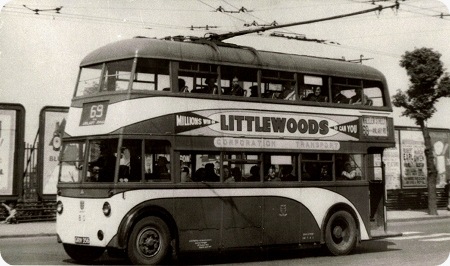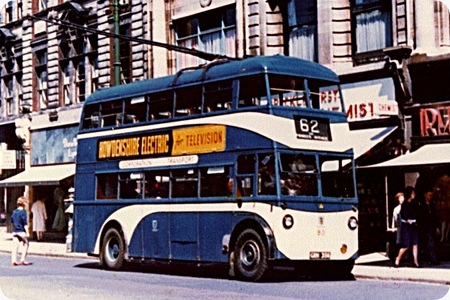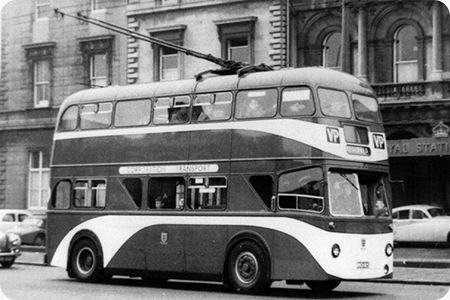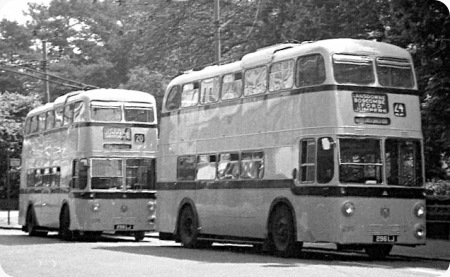Hull Corporation – Sunbeam W – GRH 356 – 80
Kingston upon Hull Corporation Transport
1945
Sunbeam W
Roe H31/29R
In order to undertake the final tram replacement along Hessle Road, in 1945. The final trolleybus route commenced on 1st of July. To operate this route 18 trolleybus chassis were purchased from Sunbeam. The first 12 were bodied by Brush of Loughborough, but the final 6 were bodied by Leeds-based Charles Roe. Number 80 is one of this final batch, which entered service in November, 1945.
Originally the seating layout was H30/26R, but along with most of the earlier trolleybuses it was upseated to H31/29R configuration in 1948.
The black and white photo shows no 80 operation along Anlaby Road, near to the Boulevard, the latter being the terminus of route 71, which, incidentally, had the only trolleybus reverser on the whole system, located at Malm Street. 80 is operating the main 69 service, in the outbound direction. The blinds are of interest, as the front blind is the 1942 wartime version, but the rear blind is the original black on white type. It is carrying a healthy load of passengers despite being on a 5 minute headway.
The colour photo shows it returning to the city centre on Newland Avenue service 62. It is seen in King Edward Street nearing the terminus. Considering the austerity of the period when they were built, they are a very handsome vehicle.
Photograph and Copy contributed by Keith Easton
———
The front blind in the top photograph is not the wartime version – the wartime version was a large number only – the number and via only display was agreed in December 1945 and gradually introduced from 1947. The rear blind is not as originally made as the Anlaby Road service was to be numbered 65 (Hessle Road would have been 66) but the renumbering in February 1942 changed this to 99. The blind was changed simply by altering the number.
Malcolm Wells
———
Hi Malcolm, many thanks for your input clearing up details on trolleybuses, a lot of the information was mainly from memory, and it ain’t always what it used to be!
Keith Easton
———
The reference to service 99 in my previous comment was a typing error – it was 69.
Malcolm Wells
———
Hull`s first batch of trolleybuses were Leyland TB4s with composite Weymann bodies. Subsequent batches by Crossley and Leyland were bodied by East Lancs and Cravens, both well known for metal framed bodywork. If this is so, does anyone know why Hull changed policy here, only to revert to timber framing (Roe) post war?
John Whitaker
———
My initial reaction would be that Hull’s East Lancs and Cravens bodies were timber-framed. I don’t know in this specific instance, but it was generally preferred in trolleybuses as metal-framed trolleybuses had to have low voltage (instead of traction voltage) lighting and in those days that required a motor-generator set which was extra weight, expense and something else to maintain, so not preferred.
Huddersfield had many East Lancs-bodied trolleybuses but only ever one metal-framed one. The motor-generator set and the associated noise was the reason why (I learnt this from Roy Brook’s excellent book on that system.)
David Beilby
———
I`m pretty sure you are right Dave re the Hull Craven and East Lancs trolleybus bodies, although they must have been to special order to be timber framed.
Motor generator sets are not the only way of lighting a trolleybus with metal bodies though, Bradford, from 1935 dispensing with this item but still retaining English Electric and Weymann all-metal bodies. I can supply more detail on this if anyone is interested, but Bradford was a trolleybus pioneer in several ways at this time.
John Whitaker
———
The debate about use of timber &/or metal framed bodies for trolleybuses is both interesting and, for the most part, true. The premise, however, isn’t. It presupposes that the move to Roe composite from any other metal was retrograde. The fact is that Roe composite bodies right up to the end (1968) were far better quality than many metal framed bodies – and that includes Roe’s own (Park Royal designed) metal framed bodies which gradually replaced them.
Evidence also suggests that the quality of Craven bodies could be suspect and that rebodying of such vehicles was not unknown.
David Oldfield
———
Further to David Oldfield’s comment, Nottingham had a series of 45 Craven bodied AEC Regents supplied in 1938, and I understand they were always regarded as much inferior in build quality to the earlier (1936) Metro-Cammell equivalents. And the inferiority of the Craven bodied first generation DMUs for British Railways was legendary!
Stephen Ford
———
Bradford was indeed a pioneer with trolleybus development, as it worked with the English Electric Company to produce a new trolleybus control system called series dynamic and rheostatic braking (SD) in 1936. This SD control system became the standard adopted by the Ministry of War Transport for the Sunbeam W/Karrier W trolleybuses built from 1943 onwards. Most of the post war trolleybuses built had the SD system of control, which was the case with the London Transport BUT 9641T BUT Q1 class. These were significantly different to the London prewar fleet that all had regenerative braking control.
Richard Fieldhouse
———
No premise intended David!
Horses for courses and all that. I am one of the greatest Roe admirers, as were Bradford Corporation, with their BUTs 740-751 !
John Whitaker
———
03/02/12 – 06:26
Pontypridd Urban District Council Transport needed extra buses during World War II for the local town services (electrified) as the petrol buses were in great demand to transport workers to the then rapidly expanding Treforest Industrial Trading Estate, (war effort) near Pontypridd.
The Trolleybuses ran a regular route from Treforest village 2 miles south of Pontypridd (not to be confused with Tref Ind Est, 4 miles south of Pontypridd)through to Pontypridd and on to Cilfynydd (pronounced Kilvunith for non welsh speakers) 2 miles north of Pontypridd where the buses turned for the return journey.
Mike Ashcroft
———
05/02/12 – 06:44
The Hull Cravens bodies on Crossley TDD4 chassis were of composite construction in accordance with Hull Corporation Transport’s specification TC2 as were the East Lancashire bodied Leyland TB7s. The Cravens bodies received major overhauls in the early 1950s (no. 46 excepted which was withdrawn in December 1954). In addition, several received new or rebuilt platforms by 1959.
Hull’s Sunbeam F4s nos 91-100 had 8 feet wide Roe bodies similar to Bradford’s 740-751 but the interiors of the Hull vehicles were far superior to the Bradford bodies. I was surprised on the first visit to Bradford in 1961 (when 91 to 100 were still in service in Hull)at the difference.
Malcolm Wells
Quick links to the - Comments Page - Contact Page - Home Page





